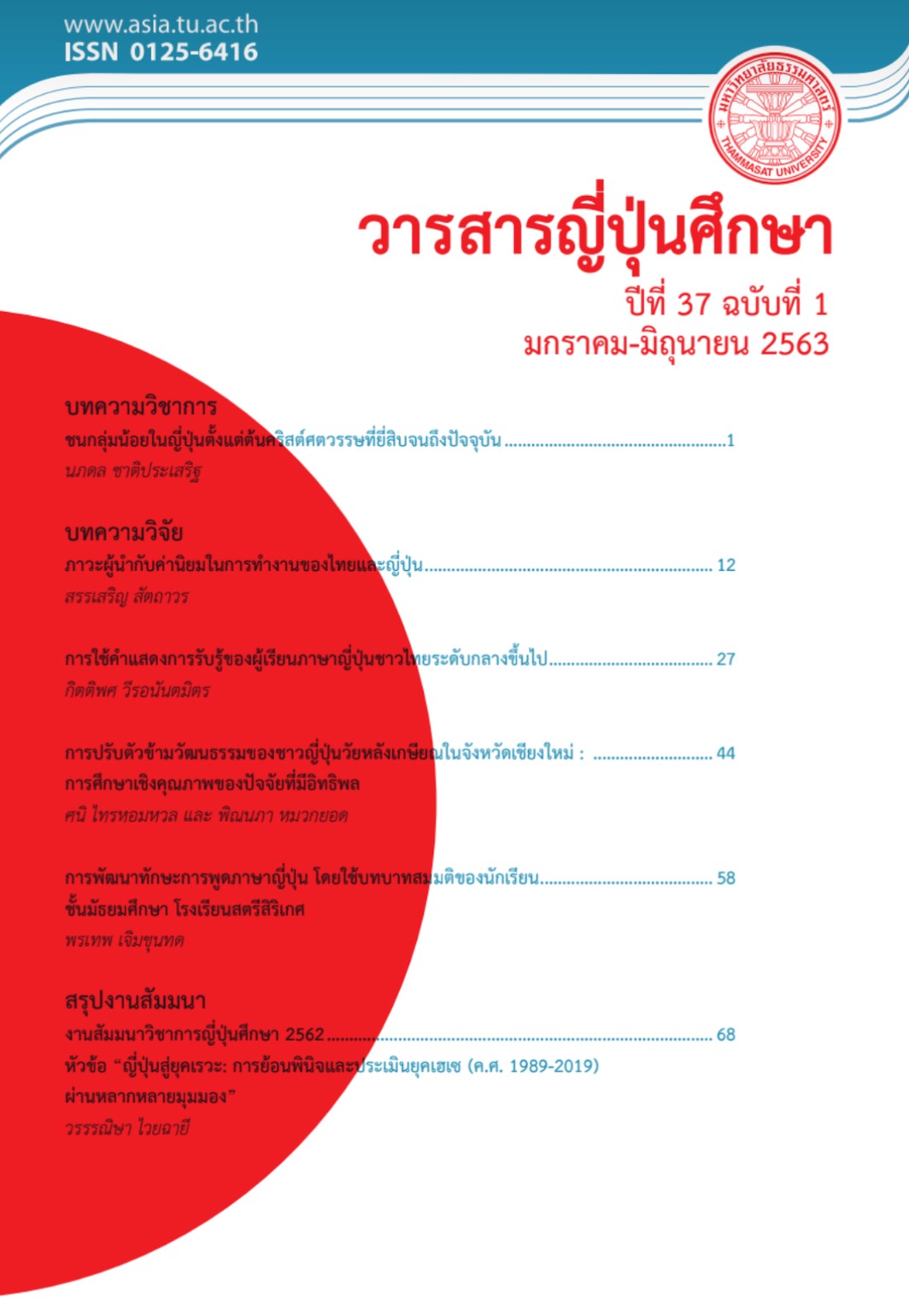Back-channels Expressions Usage of Thai Japanese-Language Learners with Intermediate Level Upward
Keywords:
Back-channel expressions, Japanese conversation, Language transfer, Transfer of trainingAbstract
This research purposes to study the natures of applying the back-channel expression while conversing with Japanese of Thai learners studying Japanese language at the intermediate level and above. The data was collected by using 1) questionnaire and; 2) simulation of conversation in the independent topic of daily living. The analysis of the results of Back-channels Expressions was then conducted.
The results indicated that 1) the Thai learners studying Japanese language rarely applied the back-channel expression; 2) the Thai learners studying Japanese language also applied the Thai language in the conversations; 3) the Thai learners studying Japanese language applied the group of (um-pattern) words which are frequently found in the textbooks and similar to the Thai back-channel expression; 4) the Thai learners studying Japanese language maximally applied the back-channel expression to signal the speaker that they are listening.
For the estimation of the causes, it could be concluded that the Thai cultural. Therefore, the competence regarding the Japanese language and opportunities to apply the Japanese language are the factors promoting the learners to well apply the back-channel expression. Promoting the leaners to develop their Japanese language capability and increasing the opportunity of applying the Japanese language with Japanese peoples in various out-of-class channels such as online chat programs will increase the learners’ performance in applying the back-channel expression.
Downloads
References
กนก รุ่งกีรติกุล และคณะ,(2559) ทัศนคติ พฤติกรรมและผลสัมฤทธิ์ทางการเรียนของผู้เรียนภาษาญี่ปุ่น คณะอักษรศาสตร์ มหาวิทยาลัยศิลปากร.วารสารอักษรศาสตร์ มหาวิทยาลัยศิลปากร ปีที่ 38 ฉบับที่ 2, หน้า 247-280
Aoki Ataya (2010) Rapport Management in Thai and Japanese Social Talking during Group
Discussion.International Pragmatics Association. Vol.20 No.3, pp. 289-313
Iwasaki Shoichi and PreeyaIngkaphiromHorie (1998) The ‘Northridge Earthquake’ Conversations: Conversational Patterns in Japanese and Thai and their Cultural Significance.Discourse and society. Vol.9 No.4, pp. 502-529
Makino, S., Hatasa, Y., &Hatasa, K. (1997)Nakama: Japanese communication, culture. context. Boston: Houghton Mifflin.
カウィター・フォーンサターポーン(2012) 「タイ人日本語学習者のあいづちの使用実態
と使用上の問題―初中級レベルの高校生の調査より」チュラーロンコーン大学文学部
東洋言語学科修士論文.
船戸はるな(2017)「継続的なチャットによる日本語学習者の相づちの使用の変化 」
『玉川大学リベラルアーツ学部研究紀要 』玉川大学リベラルアーツ学部,Vol.11,pp.19-28.
堀口純子(1988)「コミュニケーションにおける聞き手の言語行動」『日本語教育』日本語教育学会,Vol.64,pp.13-26.
堀口純子(1997)『日本語教育と会話分析』くるしお出版.
水谷信子(1983)「あいづちと応答」『講座日本語の表現 3話しことばの表現』筑摩書房
宮永愛子(2013)「日本語学習者の相づち表現の分析 : 接触場面の雑談データをもとに」『金沢大学留学生センター紀要』金沢大学留学生センター, Vol.16,pp.31-43.
村田晶子(2000)「学習者のあいづちの機能分析--「聞いている」という信号,感情・態度の表示,そしてturn-takingに至るまで」『世界の日本語教育. 日本語教育論集』Vol.10,pp.241-260.
許夏玲(2013) 「短期交換留学生に見られる日本語能力の変化とその学習環境」『東京学芸大学紀要. 総合教育科学系』東京学芸大学学術情報委員会, Vol.64,pp.359-366.
柳川子(2003)「日本語学習者を対象とした相づち研究の概観 」『言語文化と日本語教育』日本言語文化学研究会, pp.148-161.
劉丹丹(2012) 「勧誘会話における中日あいづちの対照研究」『香港城市大学.第九回国際
日本語教育・日本研究シンポジウム』香港城市大学,24-25日11月2012年
崔ハナ(2011)「日本人と韓国人のあいづち比較--あいづちの頻度、タイミング、機能について」『国文目白』日本女子大学文学研究科,Vol.64,pp.359-366.




